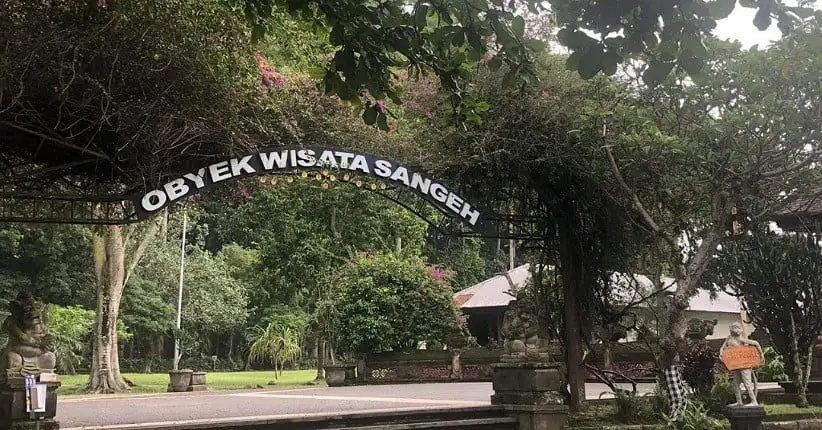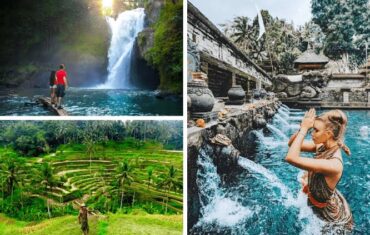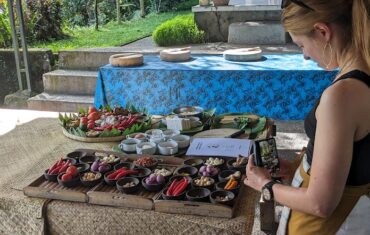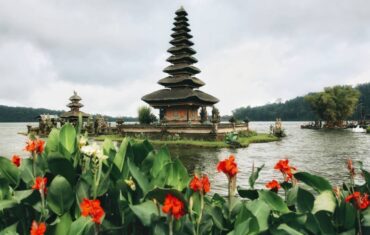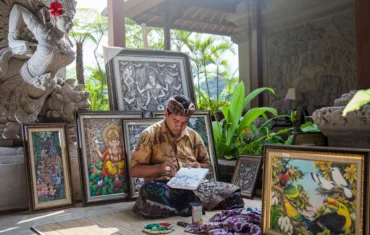Sangeh Monkey Forest
Introduction: Stepping into the Enchanted Realm of Sangeh
People know Bali, the “Island of the Gods,” for its vibrant culture, stunning landscapes, and rich spiritual heritage. Sangeh Monkey Forest stands as a captivating testament to the island’s harmonious blend of nature and tradition. Often overshadowed by its more famous counterpart in Ubud, Sangeh offers a unique and more tranquil experience. Allowing visitors to immerse themselves in a lush tropical rainforest teeming with playful long-tailed macaques and ancient, sacred sites.
Located in the village of Sangeh, Badung Regency, approximately an hour north of Denpasar. This pristine haven spans over 6 hectares and is home to hundreds of these charismatic primates. Sangeh transcends a mere monkey sanctuary, weaving deeply into Balinese mythology and spiritual beliefs as a sacred site. Where towering nutmeg trees, some hundreds of years old, provide a mystical canopy over ancient temples.
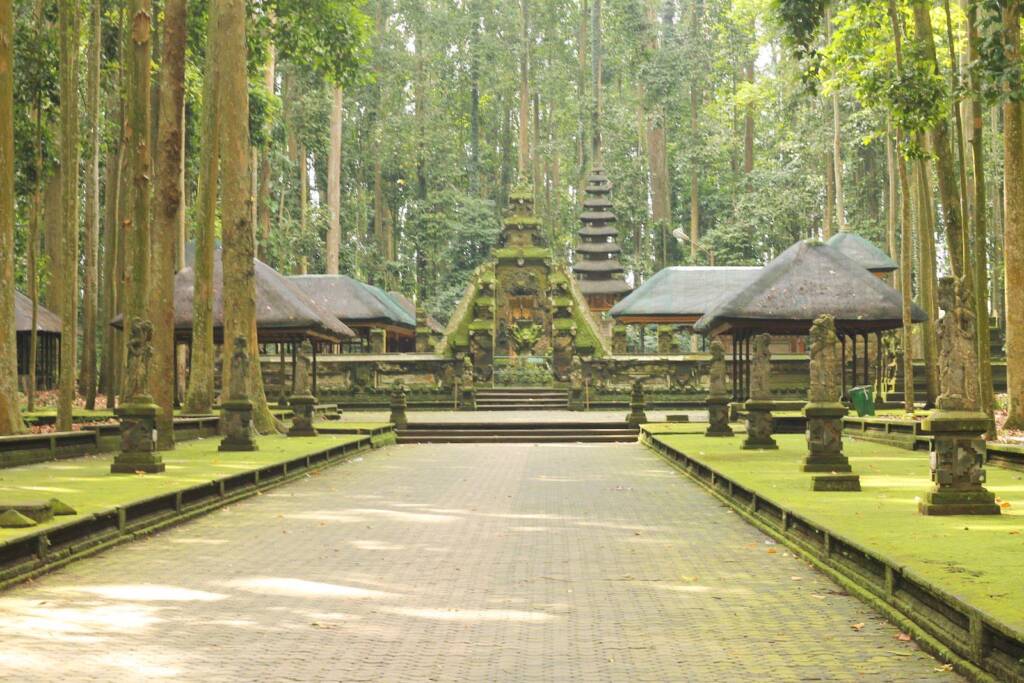
This comprehensive guide will delve deep into the heart of Sangeh Monkey Forest, offering a complete overview for prospective visitors. From its intriguing history and cultural significance to practical visiting tips, conservation efforts, and nearby attractions. Prepare to uncover why Sangeh is a must-visit destination for anyone seeking an authentic and enriching Balinese experience.
A Glimpse into the Past: The Rich History of Sangeh Monkey Forest
The history of Sangeh Monkey Forest is as captivating as the forest itself, steeped in local folklore and ancient tales. Known by locals as “Alas Pala,” meaning “Nutmeg Forest,” its origins trace back to the 17th century, during the golden era of the Mengwi Kingdom.
According to historical accounts, I Gusti Ketut Karangasem, son of Gusti Agung Made Agung, the King of Mengwi, founded a temple amidst this dense nutmeg forest. The Mengwi Kingdom bequeathed Pura Pucak Bukit Sari to Sangeh Village, building the majestic temple that still stands in the forest. Anak Agung Anglurah Made Karangasem Sakti, King Mengwi’s adopted son, practiced “rare asceticism,” or meditation, at this spot since childhood.
Sangeh Monkey Forest
A fascinating local mythology surrounds the origin of the name “Sangeh.” The word is said to be derived from “Sang,” a determiner for a person, and “Ngeh,” meaning “seeing” or “observing.” The tale speaks of the ancient Pala (nutmeg) trees originating from Mount Agung, embarking on a journey towards Taman Ayun Temple to adorn the gardens of the Mengwi Kingdom. This journey was undertaken under the cover of night to avoid being seen. However, people unexpectedly witnessed the procession of walking trees, causing them to suddenly halt. The spot where they stopped was subsequently named Sangeh, signifying “one who sees” or “being seen.” This legend beautifully intertwines the natural landscape with the spiritual beliefs of the Balinese people.
Over centuries, Sangeh has evolved into the lush and vibrant sanctuary it is today, recognized not only as a formal tourism garden but also as a revered temple area for worship. The enduring presence of the ancient nutmeg trees, some estimated to be hundreds of years old, adds to the forest’s primeval and dramatic atmosphere, making it a living relic of Bali’s rich past.
The Spiritual Heart: Pura Pucak Bukit Sari and Its Significance
At the very core of the Sangeh Monkey Forest lies Pura Pucak Bukit Sari, an ancient temple that is an active place of worship and holds immense spiritual significance for the local community. Dating back to the 17th century, this sacred site is dedicated to the worship of Lord Vishnu, the preserver god in Hinduism.
The presence of the temple within the forest underscores the harmonious relationship between nature and Balinese culture. The Balinese Hindu philosophy of “Tri Hita Karana” – the concept of maintaining harmony between humans and God, humans and their fellow humans, and humans and their environment – is beautifully manifested here. The forest itself, with its ancient trees and resident monkeys, is considered sacred, an essential component in renewing contact with the spiritual world.
The monkeys of Sangeh are not just wild animals; they are revered as sacred beings and, according to local belief, are considered the guardians of the forest and the temple. Some myths even link them to Hanuman, the monkey god from the Hindu epic Ramayana, further elevating their spiritual status. Offerings and prayers are not only made to ancestral spirits and gods but also to the spirits of the trees and statues within the forest, highlighting the profound respect the Balinese have for all living entities within this sacred space.
While visitors are generally allowed to observe the temple from outside, entry to the inner sanctum is often restricted, especially during religious ceremonies. This ensures the sanctity of the worship area and respects the local customs. The temple’s architecture, nestled amidst the dense foliage, provides a serene and spiritual atmosphere, offering a unique glimpse into Bali’s rich spiritual traditions.
Meet the Residents: The Long-Tailed Macaques of Sangeh
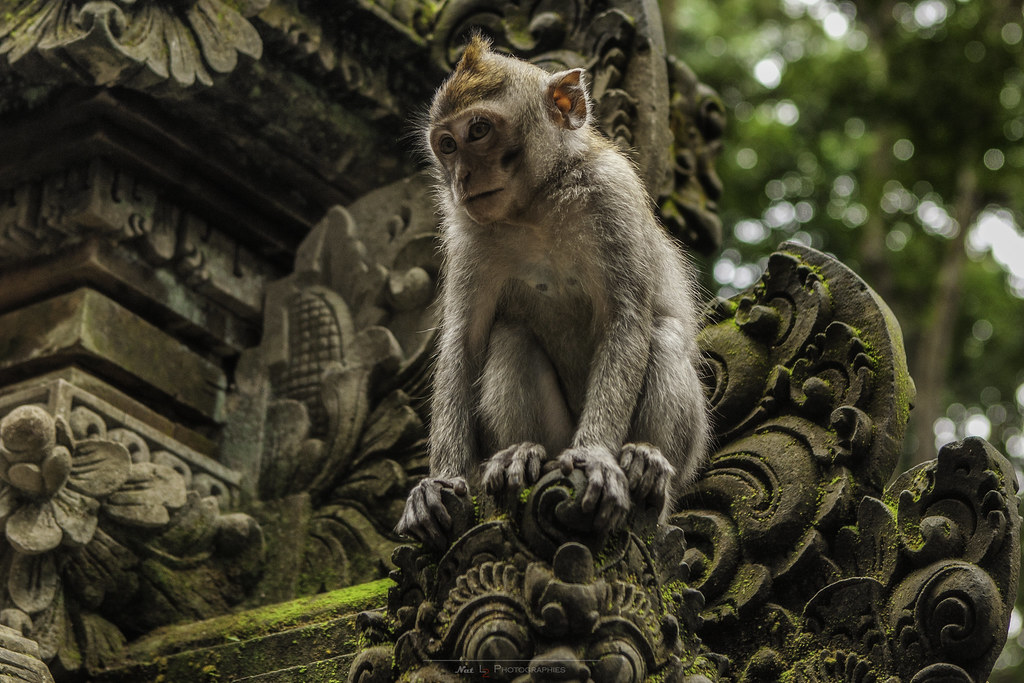
The undisputed stars of Sangeh Monkey Forest are its hundreds of long-tailed macaques (Macaca fascicularis). These grey primates are the true inhabitants of the forest, known for their playful, curious, and sometimes mischievous nature. Sangeh generally offers a more tranquil and observational experience than some other monkey forests. Visitors can enjoy the monkeys without feeling overwhelmed, though we always advise caution and respect for these wild animals.
The macaques roam freely throughout the forest, swinging from branches, foraging for food, and interacting with each other in their natural habitat. Observing their social behavior – from mothers grooming their young to dominant males asserting their presence – is a highlight of any visit. They are accustomed to human presence and often approach visitors, particularly if they believe food is involved.
Understanding Monkey Behavior for a Safe and Enjoyable Visit
Remember, Sangeh monkeys are wild animals, even though they’re generally considered less aggressive than those in other Balinese monkey forests.
Here are essential tips for a safe and enjoyable interaction:
- No Food, No Problem: The most critical rule is to never bring food into the forest, not even hidden in your pockets or bags. Monkeys have an excellent sense of smell and will aggressively try to snatch anything they perceive as food. Official feeding stations may be available, where you can feed them under supervision.
- Secure Belongings: Monkeys are opportunistic. Secure all loose items like hats, sunglasses, jewelry, cameras, and phones. It’s advisable to leave anything valuable or easily snatched in your vehicle or accommodation.
- Avoid Eye Contact: Monkeys can perceive direct eye contact as a challenge or aggression.
- No Plastic or Paper Bags: These are often mistaken for food containers and will attract unwanted attention.
- Stay Calm and Don’t Run: If a monkey approaches you, remain calm and avoid sudden movements. Running away can trigger their chase instinct.
- Don’t Provoke: Never tease, intimidate, or try to pick up the monkeys.
- Respect Their Space: Allow them their space and do not try to force interaction.
- Seek Staff Assistance: If you wish to take a photo with a monkey, politely ask a staff member or guide. They often know which monkeys are more amenable and can facilitate a safe interaction with a small treat.
- Beware of Bites: While rare, monkey bites can occur, especially if the monkey feels threatened or is trying to snatch something. If bitten, seek medical attention immediately, as rabies shots may be necessary.
By following these guidelines, visitors can have a truly memorable and respectful encounter with these fascinating creatures.
Exploring the Lush Sanctuary: What to See and Do in Sangeh Monkey Forest
Beyond the monkeys, Sangeh Monkey Forest offers a serene and captivating environment for exploration. The centuries-old, 40-meter nutmeg trees form a dense, cool canopy, offering a welcome respite from tropical heat. The forest boasts diverse life: macaques, birds, reptiles, amphibians, and small mammals. It’s a nature lover’s haven.
Here’s what you can see and do within the forest:
- Observe the Monkeys: This is, of course, the primary attraction. Spend time simply watching the macaques in their natural habitat – playing, grooming, foraging, and interacting. Their antics are endlessly entertaining.
- Visit Pura Pucak Bukit Sari: Admire the ancient temple nestled within the forest. While direct entry may be limited, its architectural beauty and spiritual aura are captivating from the outside.
- Walk the Shaded Pathways: Enjoy a leisurely stroll along the well-maintained pathways that wind through the dense foliage. The tranquil atmosphere, combined with the sounds of the forest, makes for a truly immersive experience.
- Photography: Sangeh offers excellent opportunities for nature and wildlife photography. The soft, diffused light under the canopy is ideal for capturing the monkeys in action and the lush greenery. (Remember photography guidelines, especially regarding flash and not provoking the monkeys).
- Connect with Nature: The untouched beauty of the forest provides a perfect setting for reflection and connecting with Bali’s natural environment.
- Balinese Costume Rental: Some vendors near the entrance offer Balinese costume rentals, allowing visitors to dress up for unique photo opportunities within the forest setting. (Additional fee applies).
Best Time to Visit Sangeh Monkey Forest
To maximize your experience at Sangeh Monkey Forest, consider the following:
- Time of Day: The best times to visit are generally in the early morning (around 8:00 AM – 10:00 AM) or late afternoon (3:00 PM – 5:00 PM). During these hours, the weather is cooler, the light is ideal for photography, and the monkeys tend to be more active.
- Opening Hours: Sangeh Monkey Forest is typically open daily from 08:00 AM to 05:00 PM WITA (Central Indonesia Time). However, it’s always advisable to check for any temporary closures due to local religious ceremonies or public holidays.
- Dry Season vs. Wet Season: Bali’s dry season (April to October) generally offers more sunshine and less humidity, making for more comfortable exploration. The wet season (November to March) brings more rain, but the forest remains lush and vibrant. Visits during the wet season might require an umbrella or raincoat.
Practical Information for Your Visit
Planning your trip to Sangeh Monkey Forest is straightforward. Here’s what you need to know:
- Location: Sangeh Monkey Forest, Jl. Brahmana, Sangeh, Kec. Abiansemal, Kabupaten Badung, Bali 80353, Indonesia. It is approximately 25 km north of Denpasar.
- Entrance Fee: As of recent information, entrance fees vary, often with packages that include monkey feeding. Expect prices to be in the range of:
- Adults: Approximately IDR 75,000 – IDR 100,000
- Children: Approximately IDR 50,000 – IDR 85,000
- Some packages may include fish feeding or lunch options. (Prices are subject to change, so it’s always good to verify upon arrival or check official sources).
- Parking: They usually apply a small parking fee for vehicles.
- Facilities: Basic facilities like toilets and a restaurant are typically available near the entrance area.
- Dress Code: While there isn’t a strict dress code like at some Balinese temples, it’s respectful to dress modestly, covering your shoulders and knees, especially if you plan to observe the temple. Comfortable walking shoes are recommended for navigating the forest paths.
- Guided Tours: While not always mandatory, hiring a local guide can enhance your experience, providing insights into the forest’s history, local legends, and monkey behavior.
Sangeh vs. Ubud Monkey Forest: A Comparative Look
For many visitors to Bali, the Sacred Monkey Forest Sanctuary in Ubud is the more well-known attraction. However, Sangeh offers a distinctly different, yet equally rewarding, experience:
- Crowd Levels: Sangeh is generally less crowded than Ubud Monkey Forest, offering a more tranquil and intimate interaction with nature and the monkeys. This allows for a more relaxed pace and better photography opportunities without battling throngs of tourists.
- Atmosphere: Towering, ancient nutmeg trees and less manicured pathways give Sangeh a “wild” or “primordial” feel. Ubud, while beautiful, can feel more like a controlled sanctuary.
- Monkey Behavior: Visitors often report Sangeh’s long-tailed macaques as less aggressive and more observational than Ubud’s, who are highly accustomed to human interaction and begging for food.
- Historical and Spiritual Focus: Both forests have strong spiritual ties, but Sangeh’s singular Pura Pucak Bukit Sari temple, steeped in Mengwi Kingdom history and the “walking trees” legend, offers a unique narrative.
- Overall Experience: If you prefer a quieter, more reflective experience with a deeper connection to historical legends and nature, Sangeh is an excellent choice. If you seek a more bustling, highly interactive, and easily accessible monkey encounter, Ubud might be more suitable. Ultimately, both offer fascinating insights into Bali’s natural and cultural heritage.
Beyond the Forest: Nearby Attractions and Experiences
Sangeh Monkey Forest is situated in a region of Bali rich with cultural and natural wonders. Consider combining your visit with these nearby attractions to create a full day of exploration:
- Taman Beji Griya Waterfall: A beautiful and serene waterfall, often less crowded than others, offering a refreshing natural escape.
- Taman Mumbul Sangeh: Another local attraction, often featuring water features and a tranquil atmosphere.
- Jatiluwih Rice Terraces: A UNESCO World Heritage site showcasing stunning panoramic views of expansive rice paddies, exemplifying Bali’s ancient Subak irrigation system. (Requires a longer drive, but well worth it for the scenery and cultural insight).
- Batukaru Temple: A peaceful and less-visited temple located on the slopes of Mount Batukaru, surrounded by lush forest, offering a serene spiritual atmosphere.
- Ubud Area Attractions: You can combine Sangeh with other attractions in the wider Ubud region, such as Tegallalang Rice Terrace, traditional Balinese art villages (Celuk for silver, Mas for wood carving, Batuan for painting), and various waterfalls.
- Coffee Plantations: Explore local coffee plantations to learn about the process of making Balinese coffee, including the famous Luwak coffee.
Conservation Efforts and Responsible Tourism
Sangeh Monkey Forest prioritizes conservation and responsible tourism, mirroring other Bali sanctuaries. Preserving nature, protecting wildlife, and enriching visitor experiences are our primary goals, balancing conservation with meaningful engagement.
Key conservation efforts and regulations include:
- Habitat Preservation: Protecting the ancient nutmeg trees and the overall forest ecosystem is paramount to ensuring a healthy environment for the monkeys and other wildlife.
- Regulated Visitor Access: Entry fees contribute directly to the maintenance of the forest and its facilities, as well as feeding and monitoring the monkey population.
- Responsible Feeding Programs: We carefully manage authorized feeding to ensure monkeys get proper nutrition without becoming reliant on human handouts or exhibiting aggressive begging.
- Waste Management: Strict rules are in place regarding littering to prevent environmental damage and harm to the animals.
- Educational Initiatives: We educate visitors on respecting wildlife and following safe interaction guidelines.
- The management embraces Tri Hita Karana, a Balinese philosophy fostering harmony between humans, nature, and spirituality.
As a responsible tourist, your role in supporting these efforts is crucial. By adhering to the rules, practicing mindful observation, and respecting the cultural and natural sanctity of the forest. You contribute to its long-term preservation for future generations.
Accommodation Near Sangeh Monkey Forest
While Sangeh itself is a small village, there are various accommodation options in the surrounding areas. Ranging from budget-friendly guesthouses to luxurious resorts, particularly as you move closer to Ubud or other popular tourist hubs. Some highly-rated options in the wider vicinity include:
- Ubud: As a major tourist destination, Ubud offers an extensive range of accommodations. From boutique hotels and eco-resorts to private villas. It’s a convenient base for exploring central Bali, including Sangeh.
- Abiansemal Area: Closer to Sangeh, you might find more local guesthouses and villas offering a quieter, more authentic Balinese experience.
- Luxury Retreats: Amandari, Four Seasons Resort Bali at Sayan, and Mandapa, a Ritz-Carlton Reserve, offer unparalleled luxury and serene surroundings in Ubud’s lush valleys, all within a reasonable drive of Sangeh.
We always recommend booking accommodation in advance, especially during peak season.
Conclusion: An Unforgettable Journey into Bali’s Soul
Sangeh Monkey Forest offers a profound and memorable experience that goes beyond simply observing playful primates. A tranquil oasis, Bali embodies ancient history, deep spirituality, and vibrant nature. Stepping into Sangeh unveils a wonderland of towering nutmeg trees, ancient temples, and captivating long-tailed macaques.
For an enriching visit to Sangeh, understand its history, respect its spiritual significance, and practice responsible tourism. Escape to Sangeh Monkey Forest for an authentic Balinese adventure, offering peace, nature, culture, and cherished memories. Plan your visit today and discover the captivating charm of Sangeh.
In additionally, please check on our services:

